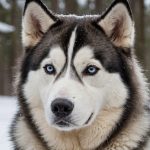Understanding Shedding in Siberian Huskies
Siberian Huskies are renowned for their thick-coated breed characteristics, a feature that significantly influences their shedding patterns. These dogs have a double-layered coat, comprising a dense undercoat and a topcoat of longer hairs. This unique coat structure means Huskies experience shedding cycles that vary throughout the year, primarily aligning with the changing seasons.
One key aspect to understand about Siberian Husky shedding is its cyclical nature. Typically, Huskies will shed their undercoat twice a year, a process commonly referred to as “blowing their coat.” This occurs during spring and autumn, allowing the dog to adapt to warmer or cooler temperatures. Observing these shedding cycles is crucial for owners wishing to manage the copious amounts of fur that Huskies can release.
Dans le meme genre : Mastering the Art of Oral Medication: Tips for Successfully Giving Pills to Your Stubborn Shiba Inu
The thick-coated breed characteristics of Huskies not only contribute to their beautiful appearance but also serve a functional purpose. Their coat helps protect them from extreme weather conditions, which is vital given their origins in cold climates. This means that while Siberian Huskies require regular grooming to manage shedding, their coat must be preserved to continue offering this protection. Frequent brushing can aid in handling their shedding efficiently, ensuring your Husky’s coat remains healthy and well-maintained without compromising its natural ability to shield them from harsh elements.
Essential Grooming Techniques
Maintaining a healthy coat and managing shedding requires a strategic approach to grooming strategies. The frequency at which you groom plays a crucial role. Ideally, aim for grooming sessions at least once or even twice weekly, especially during high-shedding seasons. This regularity helps control excess hair and stimulates the skin, promoting natural oils that keep the coat lustrous.
Sujet a lire : Creating a Hypoallergenic Home: Essential Tips for Hair-Sensitive Individuals Living Comfortably with a Portuguese Water Dog
Choosing the right de-shedding tools is equally important. Tools like the de-shedding comb or slicker brush are designed specifically to reach through the topcoat to gently remove loose undercoat hair without harming the skin. Proper technique involves slow, deliberate strokes, working from the head towards the tail, ensuring you cover all areas.
During grooming, emphasize maintaining the coat’s health. This can be fostered by not only removing loose fur but also preventing matting and ensuring skin health. This approach reduces the risk of irritation or infection. Furthermore, incorporate gentle massage techniques to enhance blood circulation and relax your pet, turning grooming sessions into a comforting experience.
Harnessing these grooming strategies offers practical benefits that extend beyond aesthetics. Healthy grooming practices enhance your pet’s well-being, minimizing allergy risks in the home while ensuring your furry companion remains at their best.
Bathing and Coat Maintenance
Ensuring your pet’s coat stays in pristine condition requires both effective bathing techniques and attentive coat care. To start, it’s important to choose shampoo recommendations that cater specifically to your pet’s needs. For thick-coated breeds, opt for shampoos that enhance volume while nourishing the skin beneath. Among the choices, look for products rich in omega fatty acids and vitamins, as they support overall coat health.
When it comes to bathing, best practices play a significant role in reducing shedding. Begin by thoroughly wetting the coat, which helps the shampoo distribute evenly. Make sure to massage the shampoo gently through the fur and skin to ensure all dirt and oils are removed effectively. Following this, rinse the coat with cool water to seal in moisture.
Post-bath, utilizing the right techniques for drying is crucial. Allowing fur to air dry might leave it prone to tangling, especially in breeds with thick coats. Instead, consider using a low-heat dryer to speed up the process while brushing slowly to avoid knots. This approach helps promote a shiny, healthy coat and minimizes the risk of excessive shedding. Through regular maintenance, these methods ensure that your furry friend’s coat remains vibrant and manageable.
Dietary Considerations for Shedding
When it comes to managing shedding in Huskies, nutrition plays a crucial role. A well-balanced diet not only promotes overall health but also directly impacts the condition of a Husky’s fur, minimising excessive shedding. Proper nutrition for Huskies should be enriched with essential fatty acids, which contribute to a lustrous and healthy coat.
Incorporating the right foods can make a difference. Opt for high-quality proteins, omega-3 and omega-6 fatty acids, and vitamin E. Foods such as salmon, sardines, and flaxseed oil are excellent choices that naturally support fur health. Additionally, incorporating whole grains like brown rice can provide essential nutrients that promote a healthy coat and skin.
Dietary supplements are another avenue to explore when aiming to enhance the coat health of Huskies. Supplements rich in biotin, zinc, and fish oil can significantly reduce shedding by nourishing the skin and hair follicles. Omega-3 supplements, in particular, are renowned for their ability to moisturise the skin and improve fur texture, thus decreasing shedding.
Ensuring that Huskies receive a nutrient-dense diet alongside appropriate supplements can lead to healthier fur and reduced shedding. It’s always beneficial to consult with a vet before making significant dietary changes to ensure what’s best for your Husky’s specific needs.
Environmental Control and Cleaning Tips
When it comes to home management and fur control, implementing effective strategies is critical to maintaining a clean environment. Reducing fur accumulation often begins with regular grooming. This simple action not only minimizes shedding but also improves your pet’s comfort and health. Maintaining a controlled environment, particularly during shedding season, further aids in minimizing fur dispersal. This can include using air purifiers to reduce airborne particles or setting up specific areas for pets that are easier to clean.
For effective cleaning of pet hair, specific cleaning solutions can be invaluable. On hard surfaces like floors and countertops, using a damp mop or microfiber cloth can capture loose hairs more effectively than a broom. Carpets and upholstery require a different approach; a vacuum cleaner with a high-performance filter makes a significant difference in removing embedded hairs. In addition to these tools, employing a rubber glove or a pet hair roller can tackle stubborn pet fur on fabric surfaces.
Home management during shedding season necessitates increased vigilance and routine cleaning. Establishing a cleaning routine tailored to your home’s surfaces prevents pet hair buildup, promoting a healthier living space for both you and your pets. Remember, the right strategies and tools make home cleaning more efficient and enjoyable.
Health Considerations Related to Shedding
Understanding the possible health issues related to excessive shedding is crucial for maintaining your pet’s well-being. Sometimes, shedding is not just a natural process but a sign of underlying health problems. Conditions such as allergies, hormonal imbalances, or skin infections can result in abnormal shedding patterns. Observing any sudden or unusual changes in your pet’s coat condition, such as bald patches or significant thinning, could warrant further investigation.
To ensure your pet’s coat remains healthy, regular veterinary advice is invaluable. Your vet can provide insight into whether your pet’s shedding is within the normal range or if it requires closer attention. Additionally, veterinarians are equipped to recommend treatments or alterations in diet if needed, potentially alleviating excessive shedding due to nutritional deficiencies.
Regular vet check-ups are essential to keep track of your pet’s coat condition and overall health. These visits allow for early detection of any issues that might be causing excessive shedding. Spotting problems early can lead to prompt treatment and a healthier life for your pet. Therefore, staying proactive in seeking veterinary advice ensures your furry companion’s coat remains lush and vibrant, reflecting their good health.
User-Friendly Guides and Checklists
Managing pet care efficiently requires well-organised resources, such as a shedding management checklist for pet owners. This checklist can play an essential role in grooming schedules and maintaining Husky coats, particularly during peak shedding periods. It typically includes daily, weekly, and monthly tasks, ensuring that each aspect of your pet’s grooming needs is addressed in a timely manner.
Shedding Management Checklist
- Daily Care:
- Brush your Husky with a slicker brush.
- Check for tangles or matting in the coat.
- Weekly Care:
- Use a deshedding tool designed for Huskies.
- Inspect ears and clean if needed.
- Monthly Care:
- Trim nails to prevent overgrowth.
- Bathe your Husky, using a shampoo formulated for double-coated breeds.
Grooming Schedules
Following a sample grooming schedule seasonally helps maintain your dog’s coat health. A spring schedule might include increased brushing to manage shedding, while winter routines may focus on keeping the coat clean and dry to prevent matting.
Additional pet care guides are also invaluable for understanding the unique needs of a Husky. Providing consistent care tailored to their specific needs not only enhances your dog’s wellbeing but also strengthens the bond between you and your furry friend.











